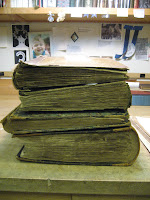Not many people realize that the corrugated clamshell box (as shown above) was actually developed here at the Library Company. As many of you know, these boxes are very useful in rare book libraries because they are an efficient way to protect and contain books that are in poor condition. Back in the 1980s, the conservation staff was making boxes out of folder stock that had long flaps that had to be folded together just right so that they could be closed with a string wound around a plastic button. They were not particularly popular with the rest of the staff. Acid-free corrugated board was still relatively new and conservators were coming up with all kinds of uses for it. Thinking outside the box, so to speak, Conservator Andrea Krupp (with some help from former conservation staff member Lillian Greenberg) came up with the brilliant idea of de-laminating the corrugated board so that the resulting flaps could be glued to create a box. The first prototypes were time-consuming because in order to beautify them the edges were wrapped with marbled paper strips. We soon realized that the beauty of these boxes is their simplicity and also their quick fabrication. Then in 1991, after making the phase boxes for several years, Andrea decided to share the box plans with other conservators and published a short article in the (now defunct) Abby Newsletter. ( To see the article, click here) Conservators had been looking for an easy, fast, and inexpensive container for their collections and the box plans caught on.
 |
| Books in need of boxing. |
 |
| Books after boxing. |
Since 1990 (when we began keeping digital statistics) we have made over 5,000 corrugated clamshell boxes of all sizes at the Library Company. We are still making the same box today, as are many other conservators. We would like to celebrate the twentieth anniversary of the corrugated clamshell’s formal introduction to the conservation world!
Jennifer Rosner
Chief of Conservation
 |
| Andrea Krupp still makes the same boxes today! |


